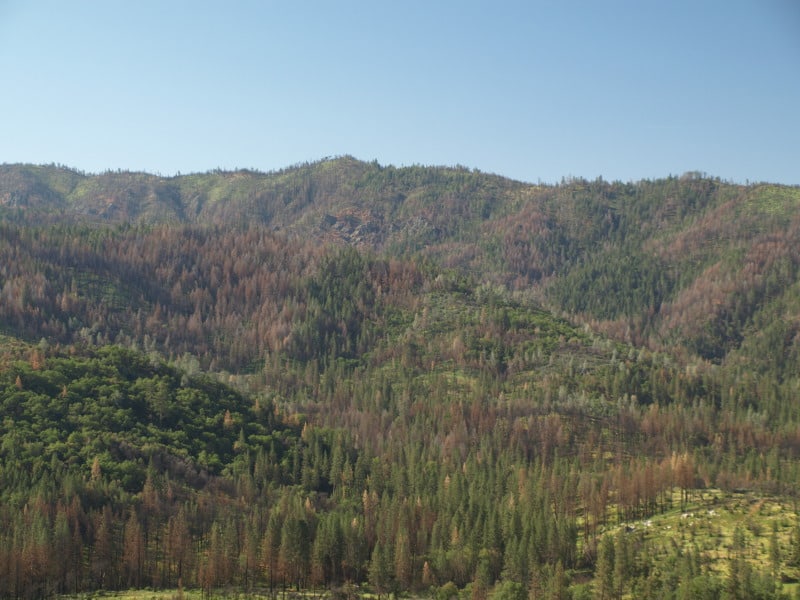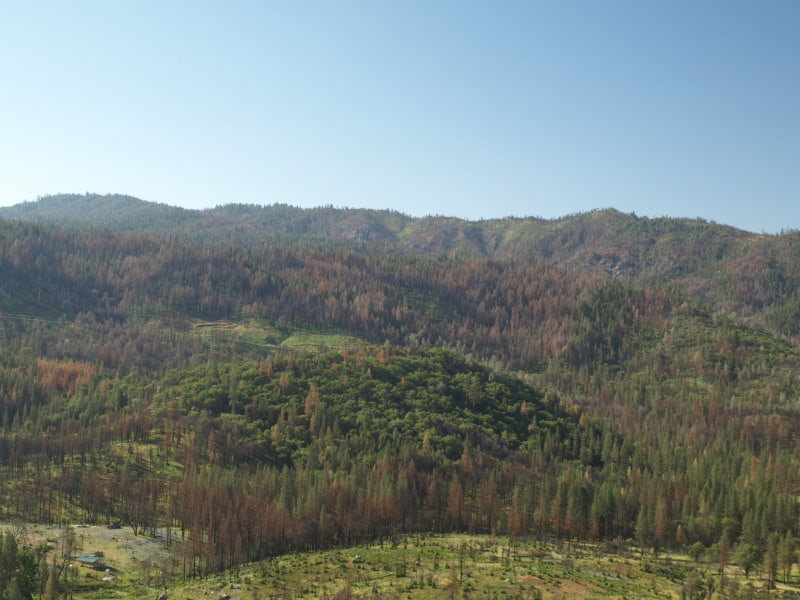My last expedition included another trip to Yosemite, and the Rim Fire. I DO think that there are enough dead trees for the owls to “enjoy” in their respite from breeding. Then again, maybe this new “Circle of Life” will provide more food, in the form of baby owls, to larger predators?
You might also notice the ongoing beetle kills, which will increase when spring and summer come into play. This next picture shows the little bit of harvesting that was done along Highway 120. You can see the drainage where the Highway sits, and you can also see how wide the hazard tree units are. The barren area in the foreground is/was chaparral.
I am glad that the Forest Service “took my advice” about getting the work done before there was any chance to appeal to a more liberal….errr….. higher court. However, is THIS what we want our salvaged wildfires to look like? This area should be ready for re-burn in a few short years. Also, be reminded that two of the plantation salvage projects did not sell, despite the prompt action by the Forest Service. My guess is that SPI was low-balling the Forest Service to get those smaller trees at less than “base rates”. That means that the prices remain the same (rock bottom) but, some of the non-commercial treatments would be dropped. It appears that the Forest Service wasn’t willing to go as low as SPI wanted. So, those perfectly good salvage trees will be left, “for wildlife”, it appears.


Thank you for the update. I think the best posts on this website are field reports with on-the-ground photos to analyze. Speaking of ground, did you happen to observe the condition of the soil surface? I can’t even see the amount of fuel. More photos would be appreciated!
I do have some more in-forest photos, from walking up the 1.5 miles to the Crane Flat Fire Lookout, within the park. The pictures should be taken with a grain of salt, being that they were along the edge of the fire, probably lit, to burn towards the main fire. They chose not to continue burning from the paved road. I didn’t see any fireline taking off from the road, though. Those pictures show a moderate burn intensity, with moderate mortality but, plenty of fuels left on the ground. The patches of high intensity were mostly limited, with much of that area being north-facing.
I’ll make another posting next week, or so.
I have been looking at a couple of forest fire salvaged projects here in Southern Oregon from last years fires.
The biggest problem with these sales, beside that only very minimal amount of acreage is to be treated, is that they should of been sold months ago. These sales won’t take place till late summer or fall giving the worms and sun a good chance to reduced the amount of recoverable timber. The small diameter trees will probably be worthless.
I think they could do a much better job of laying the sales out to make them more beneficial to the forest, and just look better, more natural. But it seems like all they are mostly only “allowed” to do roadside salvage.
You really cannot expect the Forest Service to take less than 8 months, over the winter, to put together a package. Yes, I do know how “petrifyingly” long it used to take. How long was it until the Biscuit was logging (besides the hazard tree stuff)? I have also worked on fire salvage projects that were ready to go for the next logging season, too, even surviving lower court decisions.
With the Rim Fire, I’m kind of wondering if SPI told the Forest Service that they wouldn’t be interested in low volume per acre helicopter salvage. Certainly, my pictures show plenty of volume per acre, of larger trees, that could supply their very local large log mill. If the Forest Service is holding back volume that really should come out, they have not learned from previous local re-burns. There is zero doubt that another fire will burn up all those snags, along with the Rim Fire survivors.
We do need to push the idea that today’s Federal salvage logging is merely “snag thinning”, and offers the best compromise between ecology and economy. These ideas are for Sierra Nevada Forests, where tree rings show frequent low intensity fires. The human-less forest concept is a flawed fantasy, in most forests.
Science shows that salvage logged plantations suffer greater canopy damage during reburns compared to naturally recovering forests. (I have zero confidence that Larry can incorporate this evidence into his counter-factual belief system which is clogged with unfounded fear of reburn.)
I seriously doubt that anyone has even studied such a thing, using formal scientific methods. My evidence is in the pictures I have presented here, many times, showing the results of doing nothing (in Yosemite) after catastrophic wildfires and re-burns. My fears include the loss of precious old growth nesting habitats and seed sources. Show us all the site-specific “science” that shows your own unfounded claims, please. (Of course, such studies do not exist!) You cannot compare plantation recovery to “naturally recovering forests”. Apples versus oranges, bud!
Take a close look at the first picture, and you can see the extent of the fire’s mortality, in the conifers. I guess the best question is: Does anyone think that this condition is acceptable, in a scientific and well-rounded way, including expected future climate impacts?
(A little background on this land. In the foreground are parcels of private land, including some City “Camps”. The rest of the picture is probably 90% Forest Service. The most distant ridge was burned in the 1987 Complex. The foreground chaparral has burned several times in recorded history. It will return as more brush. I would have to guess that some of the thicker forest is in a PAC, or maybe just too rugged and rocky to log.)
The one thing we absolutely do know is that this area WILL burn again, in the next few decades. Wood doesn’t rot very fast in this dry environment, and the accumulated fuels will only go away through large wildfires, if we let it happen.
One thing that always kind of shocks me is the amount to trees that keep dying each year after the fire.
I have seen whole watersheds that were green after the fire turn brown the next year, with mortality decreasing the following years but trees still dying. This was especially surprising to me in some areas where younger stands were backburned. Most of these plantations are never logged because the trees are too small and by the time they would of been sold they are full of bugs and/or cracked to the heart.
I’m hoping that they will keep those contracts open, to allow the harvest of trees that met the guidelines after the loggers have came and went. It would just be a smart move by both purchaser and the Forest Service. It is also important to be able to cut more roadside hazard trees, too. Yes, getting in there and cutting salvage trees quickly has a downside, when more trees die, due to bark beetles and cambium damage.
Derek should weigh in here as he hit the Brush Creek fire with his camera a couple years in. There was a high amount of slow mortality mainly due to root damage in the duff on the older stands the USFS had been managing to “protect.”
I’m repeatedly appalled and disgusted as I revisit lots of the 21 century wildfire runs up here in the holy Crown of the Continent E C O S Y S T E M. So much habitat trashed, so much merch wood wasted, so vulnerable to a re-cook. Snags are fine, but how many BBWPs does the planet need?
Meanwhile in ‘legal world’ last week …….
http://www.courthousenews.com/2015/05/11/logging-foes-tell-9th-circ-to-think-of-the-owl.htm
Using their analogy, when your nearest food source IS in Sacramento, you DO make that trip, otherwise, you move closer to it. (That is what the resident owls did before the fire.) They have not proven that occupancy means feeding success. Thick, dead stands do not offer much prey, for spotted owls. At least, not for the next 5 years, or so. There is no lack of foraging habitat for owls. They forage where the prey is, and that is usually in open stands with “edge effect”. Their “study” does not prove much, other than that the owls survived the fire. I think that we CAN assume that nests were destroyed and that nesting habitats were harmed.
I was just up there, yesterday, and I have seen log truck loads, with burned Federal logs, still coming out of the fire area. I’m not sure about whether there is still felling going on. I doubt it, other than picking up more insect mortality.